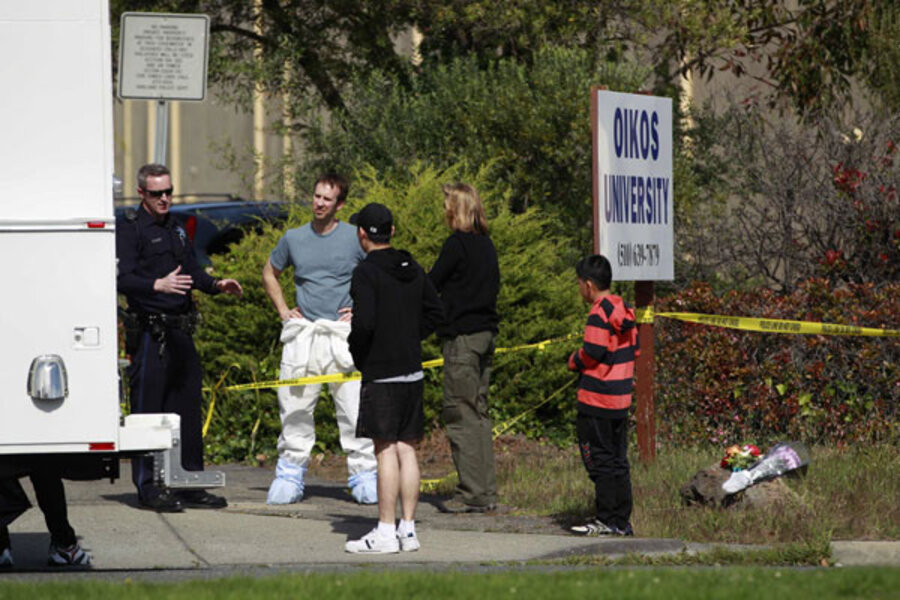Oakland school shooting: Is there a lesson to be learned from the tragedy?
Loading...
| Los Angeles
Would a school counselor have detected the shooter’s mounting frustrations before he attacked? Should students have reacted more forcefully in their own defense?
As more details trickle out about the shooting rampage Monday morning that claimed the lives of six students and a receptionist at Oikos University in Oakland, criminologists, behavioral experts, and others are trying to glean possible patterns and lessons from the episode.
Police say they have established several ostensible motives – from the suspect having been teased for bad English, to his despair over the recent deaths of two family members, to a combination of factors.
Oakland Police Chief Howard Jordan told reporters Tuesday that the suspect – a South Korean national, 43-year-old One Goh – had recently been expelled from the university, for his apparent inability to curtail his own anger. He said Goh was being congenial with police interrogators but showed no regret for the murders.
Several students, interviewed on NBC, said that Goh, being from South Korea, didn’t fit in because of the language barrier.
Six of the victims were women, foreign nationals from Nepal, Korea, the Philippines, and Nigeria.
“This shooting does seem to be a rather typical ‘going postal’ killing, [with] many similarities to other shootings … indebtedness, depression, alienation … [a] sense of injustice and hopelessness,” says Emil Chiaberi, director of the 2010 documentary film, “Murder By Proxy: How America Went Postal,” via e-mail.
“The frustration tends to build up over a period of time. Like other mass killers, this person didn’t just snap, but had meticulously planned the shooting,” he says.
Mr. Chiaberi and others say one factor that has not been given much attention in America is bullying among adults.
Chiaberi says bullying tends to be the main driving factor in most mass killing incidents, quoting a Zogby poll that found close to 50 million people experienced bullying in the workplace.
“It's a huge problem. It's really a hidden epidemic. Workplace killings are just a tip of the iceberg, because only a very tiny percentage of people who experience bullying resort to violence," says Chiaberi. "Same could be said about schools. The real problem is that somehow our culture produces a lot of depressed, powerless, alienated, angry, and hopeless individuals who blame others (employers or society) for their problems.”
Jesse Klein, assistant professor of criminal justice at Adelphi University and author of “The Bully Society: school shootings and the crisis of bullying in America’s schools,” says of 191 school shootings from 1979-2011, 30 percent that were related to expulsion or suspension were directed at administrators, and 50 percent involved challenges to masculinity.
“Students picked up guns to protest being disrespected,” she says, noting it is quite common, as in the Oakland case, to have more than one reason.
Dr. Chuck Williams, director of the Center for the Prevention of School-Aged Violence at Drexel University, says the growing number of such incidents points to the dramatic need for counseling programs.
“Not in the history of this country have we had as many of these incidents as in the past several years,” he says. If the school had had a counselor to advise Goh, it might have made all the difference, says Williams, because the counselor would have picked up all the signs of Goh’s reasons for anger and depression.
“The counselor needs to make sure someone who is let go like Goh has a transition plan. They need to ask about future plans and goals and if the person is OK with his termination,” says Williams. “We are finding out too many times after it’s too late that they are not OK and are coming back to kill to make a point.”
Spurred by the growing numbers of such incidents, police at Otterbein College in Ohio have begun taking a proactive approach. It includes threat assessment teams that meet every other week to discuss any issues with students such as anger management and mental health issues that hopefully will be able to detect a potential danger before it becomes an issue.
The approach includes training courses several times each year for students, faculty, and administrators in how to deal with a shooting attack, demonstrating the options of running, hiding, barricading – and attacking the shooter if no other option exists.
In the Oikos University killings, the victims were lined up and shot execution-style, meaning the attack-the-shooter option would perhaps have been the most effective, says Larry Banaszak, the Otterbein chief of police.
"No matter if it's high schools or colleges and universities, we need to have training to be able to respond to these incidents as they happen,” says Mr. Banaszak, via email.
“Prevention is good and fine but these incidents have happened in the past, are happening in the present and will continue to happen in the future,” he says. “We can't keep putting our heads in the sand and pretending like it can't happen here. The shooter lined people up along the wall. There needs to be training for people to react as soon as the threat is recognized."





